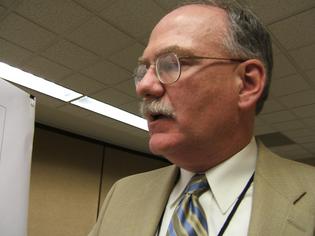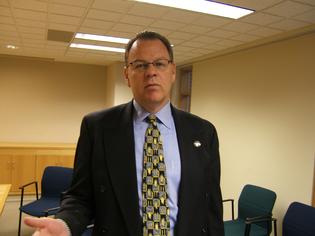
 The governor sent a delegation to New Haven Monday to meet with city officials about how to stop drivers from killing people on Ella Grasso Boulevard, where crashes have caused seven deaths in just the past three months. State traffic engineer John Carey (in top photo) left the meeting saying that quick fixes under consideration include putting up so-called “rubber duckies” like the one at left.
The governor sent a delegation to New Haven Monday to meet with city officials about how to stop drivers from killing people on Ella Grasso Boulevard, where crashes have caused seven deaths in just the past three months. State traffic engineer John Carey (in top photo) left the meeting saying that quick fixes under consideration include putting up so-called “rubber duckies” like the one at left.
No one died in car accidents on Ella Grasso Boulevard through all of 2005. Suddenly, since this February, seven serious accidents have taken place on the wide state road. Two unborn babies and five other people have died. Click here to read the city’s description of those seven accidents.
Three of the seven accidents occurred at the treacherous intersection where southbound drivers turn from the Boulevard across traffic onto Legion Avenue. Drivers often misjudge where and when to turn in the face of onrushing cars.
After an illegal drag race killed two people and injured three others in the latest accident, at 1 a.m. Saturday, Gov. Rell ordered her staff to come up with recommendations by this coming Friday for making the Boulevard safer. (Click here to read her release.)
So Carey and other representatives of the state Department of Traffic (DOT) and the state police huddled in a second-floor City Hall conference room Monday morning with, among others, New Haven Chief Administrative Officer John Buturla, police Capt. Stephen Verelli, and traffic and parking chief Paul Wessel. The meeting lasted from 9:30 a.m. to 11 a.m.
The group went over each accident and discussed both short-term and long-term responses. Carey said his group won’t have a final list of short-term recommendations for the governor until Friday, but some clear suggestions emerged.
Several of the suggestions deal with the killer Boulevard-Legion intersection. They include:
• Those rubber duckies. Their official formal name is “temporary post delineator.” The plastic striped posts stand about 3 feet tall. The idea is to place them by the Boulevard-Legion intersection to help drivers better gauge where to turn and where the center of the road is. Right now only a painted line separates the barreling southbound and northbound lanes.
• Moving the painted “stop bar” back 30 to 40 feet for southbound cars about to turn left. “That’s something we can do quickly because it’s just paint on pavement,” Carey said.
• Better illumination. Carey said his crew will examine whether lights along the road need to be brighter, whether dark spots require additional lighting.
• A possible electronic warning sign for drivers.
Two other accidents have involved pedestrians. A pedestrian struck at the multi-headed Orange Avenue/Route 1/ Boulevard intersection lost both legs after getting hit by a driver. A hit-and-run driver killed a pedestrian crossing the Boulevard at Truman Street. Carey said his crew will examine pedestrian crossings to see how to make them safer. One possibility: advance signs to remind drivers. He’s looking at a possible crosswalk by the busy soccer fields, too.
What About Calming?
 Meanwhile, the city will move ahead with its own short-term measures, said Chief Administrative Officer Buturla (pictured).
Meanwhile, the city will move ahead with its own short-term measures, said Chief Administrative Officer Buturla (pictured).
He said the city will run “saturation” patrols of the Boulevard, in conjunction with state cops, to catch speeders. It may start using cameras to identify speeders. Cops gave out 40 speeding tickets on the Boulevard between 8 p.m. Saturday and 4 a.m. Sunday.
But, Buturla said, “all the traditional methods of deterring people’s behavior have not been successful. So let’s look at some non-traditional methods.”
Because the mayor failed to convince the legislature to pass a state law on the subject, the city can’t use those cameras alone to identify and then send tickets to drivers. But it can still send warning letters to speeders caught on camera and use footage to supplement cases against drivers caught by cops, Buturla said. He said the city will also look at whether overhead traffic signals at the killer intersection are easy enough to see.
Looking at the long term, East Shore Aldermen Al Paolillo (pictured) wants the city to do more “traffic calming.” That’s a term for changing roadways to slow traffic.
Paollilo and Morris Cove Alderwoman Arlene DePino have been working with neighbors and city public works chief Dick Miller for almost three years on a traffic-calming plan for Woodward Avenue. It will probably come on line by the summer, Paolillo reported. It will include drawing out corners to make streets narrowed and adding traffic circles.
Paolillo said he’d like to see a city government traffic-calming working group reestablished and have it include aldermen. Streets all over town need traffic calming, he said. Including the Boulevard.
He shouldn’t get his hopes up for that one. It’s a state road. So it’s up to the state whether to reconfigure the street to slow down the thousands of cars that travel there daily. The state’s Cary was clear when asked about the subject. “Not on Ella Grasso,” he said. “For traffic calming to be successful, you need an alternative street to move the traffic to.”
The officials’ strategy comes down to three “e“s: Enforcement. Engineering. And “education.” That last part, they said, includes media outlets like this one sending drivers on the Boulevard this message:
Please slow down!

Enforcement: why is it a new and shocking sight to see patrol cars pulling over so many speeding vehicles on the Boulevard this evening? Perhaps because it IS a new sight! And a welcome one, too, for the week or two that it will last until the media heat is off again. Hasn't anyone from the city figured out that we might make so much revenue from these tickets that it would more than pay for the Police time and equipment?
Engineering: in New Haven? That would be funny if it wasn't so sad - and tragic. How dare the city and state try to confine the assessment to such a short section of the roadway. What about the lack of marked lanes on other sections around Edgewood Park, or the glaring lack of marked, dedicated left turn lanes and signals at the Chapel Street intersection, or the lack of marked lanes for the left turn signal at the Whalley Avenue intersection, etc. Using the word "Engineering" in the same sentence with "Ella Grasso Boulevard" is an insult to the profession of real traffic engineering.
Education: good luck. The roads are full of angry, selfish drivers that constantly speed, run red lights, make rapid unsignaled lane changes to pass out vehicles not traveling at twice the posted speed limits, etc. The last fatal crash on the Boulevard was caused by idiots drag racing, not the bad engineering. The best education would be thousands of expensive tickets with media coverage. Then, slowly, it may dawn on people that they really do have to obey those traffic laws.